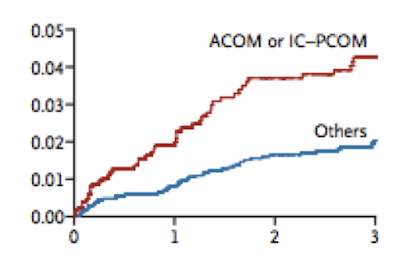 ISUIA (prospective)
ISUIA (prospective)
- 1991-1998
- N=4060 patients (1692 no surgery, 1917 surgery, 451 endovascular)
- Overall rupture rate -- 3% over 4.1 years of follow up; 65% mortality with ruptures
Rupture rates by location, size and presence of previous SAH*

*All aneurysms examined in this study were unruptured, however some people in the study had a history of SAH from another source/another aneurysm. Those were designated as "group 2" --- vs "group 1", which denotes those who had no history of SAH.
Graphical representation of rupture rates by size and history of SAH:
Multivariate model of predictors of aneurysmal rupture:
Size:
<7 mm (ref)
7–12 mm, [RR] 3·3 [95% CI 1·3–8·2], p=0·01
> 12 mm, [RR]17·0 [8·0–36·1], p<0·0001
Location:**
ICA (ref)
Basilar tip - [RR] 2·3 [1·1–4·8], p=0·025
Cavernous - [RR] 0·15 [0·04–0·64], p=0·01
Pcomm - [RR] 2·1 [1·1–4·2], p=0·02
Age: [RR] 1·007, [0·98–1·03], p=0·56
- Morphological characteristics such as multiple lobes, presence of a daughter sac, and a family history of subarachnoid haemorrhage were not predictive of SAH
**other locations not statistically significantly associated with rupture
Table comparing the observation vs intervention cohorts.
Criticisms of the study:
- Data from 1991-1998 -- before the era of widespread use of aspirin and statins, which decrease the rate of aneurysmal rupture. Also really before the era of endovascular techniques, which have significantly altered practice patterns such that the data from the people who were observed during this study is unlikely to apply to people we would observe today.
- Not randomized -- (most) everyone who was believed to be a high rupture risk underwent surgical or endovascular interventions; thus there's a selection bias for the low-risk aneurysms, thus possibly leading to an artifically lower rupture rate in the observation group.
- Selection bias of older, sicker patients -- The 5 year KM mortality in this group was 12.7% -- you would expect <1% in an age-matched control cohort. The observation group was likely enriched for poor surgical (and poor mid-90s era endovascular) candidates -- many died from cancer, heart disease, etc; About half of the patients died from intracranial hemorrhage events, many of which were NOT counted as rupture events but as censored -- patients who died from intracranial hemorrhage that could not be definitively attributed to the aneurysm were counted as censored. Another group (I can't remember which, but I think it was the TEAM group) re-analyzed the data counting all these censorship events as rupture events and found the overall annual rupture rate to be 1.2% vs 0.8% - a 50% difference although a small absolute difference.
- 32% censorship/crossover for treatment -- enough said.
- <22% with >4 years of fu -- enough said.
- Included cavernous carotid aneurysms - which are known to have a very, very low rupture rate.










